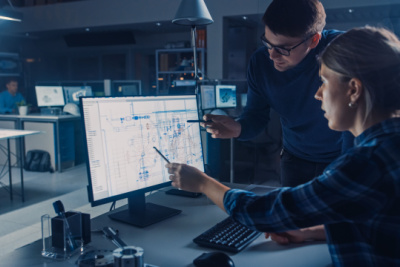Security consultants should work with facilities management on the design and implementation of security methods and technologies in order to have the best facility security possible.

Facilities Management Advisor’s FM Now: Secure Buildings online summit was held on June 20 and included an opening keynote session called “Design Development Considerations for Security Systems.” The session featured Frank Santamorena, Senior Physical Security Specialist with the U.S. Department of the Treasury and president of Security Experts, Consulting and Design, LLC.
5 Phases of Security Design
Santamorena talked about five common architectural deliverables for each phase of security design.
The five phases of security design and construction include:
- Schematic design: Includes the facility’s floor plan, project goals, security needs, and the research phase of the project to determine requirements.
- Design development: Lays out mechanical, electrical, plumbing, structural, and architectural details of the facility, as well as the location of security desks, system devices, and hardware, including a visitor management system and card readers.
- Construction documents: Provide specifications for facility construction materials. The security consultant produces detailed drawings of exterior finishes for desks, access control devices, surveillance devices, and door hardware.
- Bid or negotiation phase: Bid documents go to potential security contractors for pricing. The security consultant makes a recommendation for contractors they’ve used before. Determine if any bids have specifications that would compromise facility security.
- Construction phase: Security consultants should be at the facility’s construction site regularly to answer questions and ensure workers know what they’re doing and that they aren’t taking shortcuts.
To help meet these deliverables, he recommends security consultants talk to the decision-makers, whether they be building owners, facility directors, or architects.
Physical Security Information Management
Santamorena explained the importance of having a physical security information management (PSIM) system, which is when different security, life safety, and building automation technologies work together.
PSIM is “actually software that ties into all these disparate systems, these independent operating systems,” he said, adding that it allows security professionals to instantly see a camera image of an area where an alarm has just sounded.
Regarding PSIM retrofits, he explained, “We want to know what legacy systems the owner has, what new systems the owner is open to, and what they want to be tied into this PSIM.”
Maintenance Services
Santamorena strongly encourages facilities to have security system maintenance programs to reduce equipment downtime and have greater security system reliability.
He also suggested that facilities have a security repair services team, not just for access control and video management but also for other systems like fire, intercom, and building automation services. This would prevent them from having to wait for an extended period before someone can come to fix the issue.
Santamorena also believes a security integrator should come on-site at least annually to evaluate and inspect the condition of facility security equipment.
As for security retrofits and upgrades that can not only address losses due to criminal activity but also increase employee safety, he explained that “we like to have a shelf life on this equipment and you’re going to budget into that into your security systems, into the construction document phases into the specifications itself. Do you have a 3-year, a 5-year, 7-year, or 10-year retrofit and upgrade for certain equipment?” he asked.
Whether it’s a new security integrator or a legacy one, Santamorena recommended that facilities participate in a security service partner program, giving them access to trained and experienced technical support staff.
Training and Procedures
Last but certainly not least, he recommends that people be trained on how to use security systems in the building. The use of these systems should follow the company’s policies, procedures, and processes, which is, in and of itself, an effective way to improve building security.
“The most typical weakness in most security programs plans is the absence of a comprehensive risk and vulnerability assessment. And most plans only address security from an electronic systems perspective,” he said, adding that once the assessment is completed, policies and procedures should be changed, which generally can be quick to implement and low in cost.
He explained that staff should be notified when policies and procedures are changed and educated on the reasons they were changed and why it’s important they follow the new policies and procedures. The key to success is based on their constant implementation.
As an example, he believes security departments shouldn’t allow anyone to walk in after someone else has gained access at an access control point. He says security should ensure each individual keys into a specific area or room.
Learn More
To learn more about security design systems, check out the webinar on demand by clicking here.
